Tips for Trimming Weeds Along a Fence
- September 26, 2024
- 0 comment
Weeds along your fence can ruin your yard’s appearance and cause long-term damage by trapping moisture, leading to rot or rust. Fortunately, with the right tools and regular maintenance, you can effectively keep your fence weed-free and looking its best.
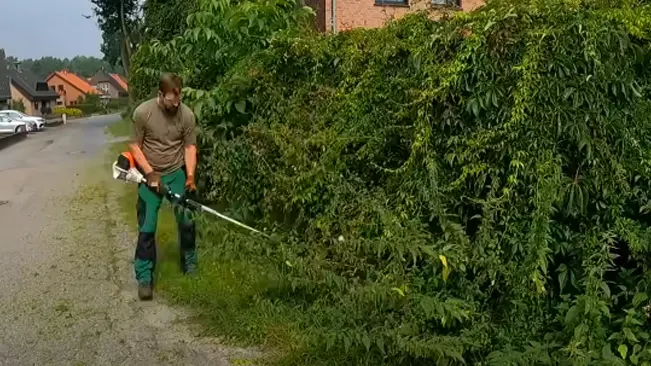
In this article, we’ll cover practical tips for trimming and managing weeds along your fence, discuss how different factors impact weed growth, and explore ways to prevent them from coming back.
Factors Affecting Weed Growth Along Fences
1. Soil and Sunlight
Weed growth along your fence depends on the soil type, sunlight, and moisture levels, with sunny areas favoring grasses and shady, damp spots supporting moisture-loving plants.
Example: A fence in a shaded, damp area might see moss and other moisture-loving weeds, while a fence in direct sunlight may become overrun by fast-growing grasses and vines.
2. Fence Material
Different fence materials interact with weeds in various ways. Wooden fences are particularly vulnerable to weeds because moisture retained by the plants can cause the wood to rot.
Metal fences, like chain-link, can rust if weeds trap moisture against the posts. Vinyl or plastic fences are more resistant to weathering but can still suffer from overgrown weeds affecting their appearance.
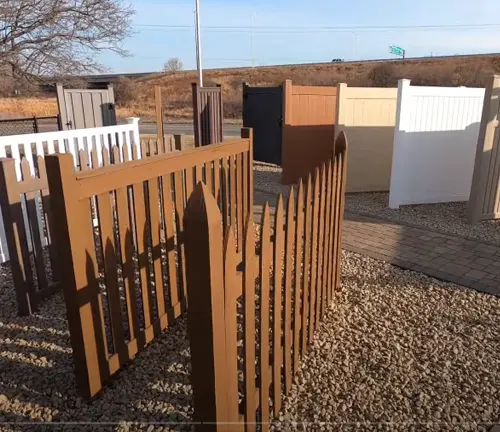
Example: If you have a wooden fence, it’s important to trim weeds regularly to prevent moisture buildup that can lead to rotting.
3. Proximity to Lawns or Gardens
The type of landscaping near your fence can affect weed growth. Lawns with healthy grass often have fewer weed issues, but flower beds or gardens can spread weed seeds to the fence line if not properly managed.
Types of Weeds Along Fences
Understanding the type of weeds growing along your fence will help you choose the right tools and techniques to remove them.
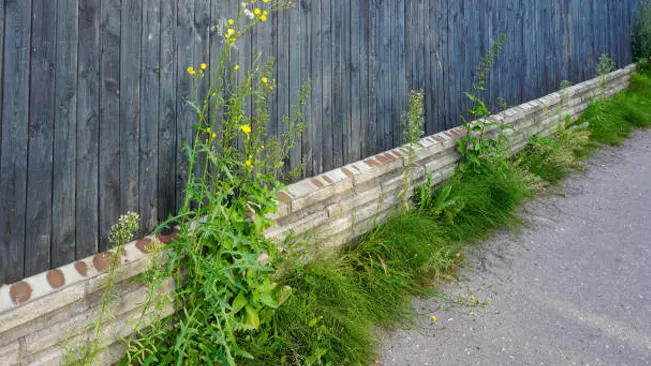
1. Grasses
Grasses, such as crabgrass, are fast-growing and can easily take over a fence line. They often grow densely and spread rapidly if not regularly trimmed.
2. Vines
Vining plants, like morning glory or bindweed, can quickly climb fences. These can be particularly harmful as they pull on the fence structure and cause damage over time.
3. Broadleaf Weeds
Dandelions, thistles, and other broadleaf weeds can establish themselves along fences, often pushing up against posts and creating pressure that may loosen them over time.
4. Creeping Weeds
Creeping weeds, like clover and ground ivy, grow horizontally along the ground and can become tangled at the base of a fence. They spread quickly and are difficult to remove once established.
Practical Tips for Trimming Weeds Along a Fence
1. Select the Right Tools
Using the right tools makes trimming weeds along a fence much easier. A string trimmer is great for light trimming, while pruning shears work well for thicker weeds.
- Tip: Use a string trimmer for general maintenance and pruning shears for thick weeds.
2. Install a Weed Barrier
A weed barrier, such as landscape fabric or mulch, helps prevent weeds from growing back. It blocks sunlight, reducing the need for frequent trimming.

- Tip: After trimming, lay down landscape fabric and cover it with mulch or gravel to prevent future weed growth.
3. Apply Natural Weed Killers
Natural weed killers like a vinegar solution can effectively kill weeds without harming the environment. Spray directly on the weeds, avoiding nearby plants.
- Recipe: Mix 1 gallon of vinegar, 1 cup of salt, and a tablespoon of dish soap for an effective natural weed killer.
4. Regular Maintenance
Weed control requires regular attention. Aim to trim weeds along your fence at least once a month during the growing season. This will prevent weeds from becoming too tall or overgrown, making them easier to manage.
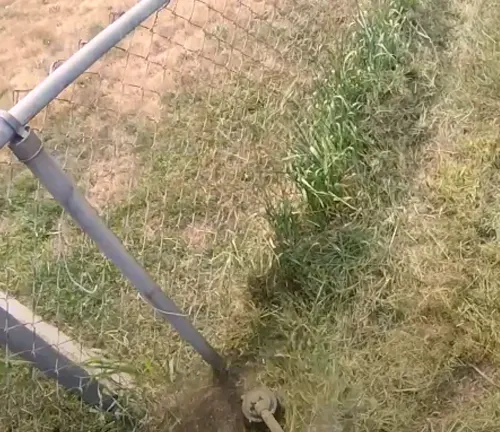
- Tip: Schedule monthly trimming sessions in spring and summer to keep weeds under control.
5. Protect Your Fence
Be careful when trimming near your fence to avoid damaging the material. Use hand tools to manually remove weeds that are too close to the fence structure.
- Tip: Use hand tools to remove weeds directly against the fence to avoid damaging the structure.
Conclusion
Keeping weeds under control along your fence doesn’t have to be a daunting task. By understanding the factors that contribute to weed growth, choosing the right tools, and implementing preventative measures like weed barriers and natural weed killers, you can maintain a clean, attractive fence line. Regular maintenance is key to preventing weeds from becoming overwhelming.
By following these practical tips, you can ensure your fence remains in good condition, free from the damage that overgrown weeds can cause.
Frequently Asked Questions (FAQ’s)
- Why is it important to trim weeds along a fence?
Weeds can trap moisture against the fence, leading to rot, rust, or long-term damage. - What tools are best for trimming weeds along a fence?
A string trimmer is ideal for light trimming, and pruning shears work well for tougher weeds or vines. - How often should I trim weeds along my fence?
You should trim weeds at least once a month during the growing season to prevent overgrowth. - Can I prevent weeds from growing along my fence?
Yes, using a weed barrier like landscape fabric or mulch helps prevent weed growth. - What natural methods can I use to kill weeds along a fence?
A mix of vinegar, salt, and dish soap is an effective, natural weed killer. - What types of weeds commonly grow along fences?
Common weeds include grasses, vines like bindweed, broadleaf weeds, and creeping plants such as clover. - Can weeds damage my fence?
Yes, weeds can cause damage by trapping moisture, leading to rot in wood fences or rust in metal fences. - How can I protect my fence while trimming weeds?
Use hand tools near the base of the fence to avoid damaging the fence with a string trimmer. - What is the best way to remove weeds that grow right against the fence?
Hand-pull weeds that grow close to the fence to avoid damaging it with trimming tools. - Are chemical weed killers safe to use near a fence?
Chemical weed killers can be effective but may harm nearby plants; natural alternatives are a safer option.

Charles Hayes
Forestry AuthorI'm Charles Hayes, I bring over 15 years of specialized expertise in landscaping and woodworking, blending artistic design with sustainable environmental stewardship. My career, fueled by a profound passion for the natural world, encompasses extensive education and hands-on experience in creating harmonious, eco-friendly outdoor spaces and responsibly managing forest resources. Recognized for my professional standing, I am committed to continuous learning and certification in cutting-edge practices. My expertise is not only reflected in my work but also in my contributions to community projects, educational workshops, and collaborations with industry leaders. As an authoritative voice in my field, I strive to share knowledge and promote environmentally conscious approaches, making me a trusted resource in landscaping and forestry.


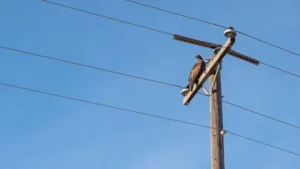










Leave your comment